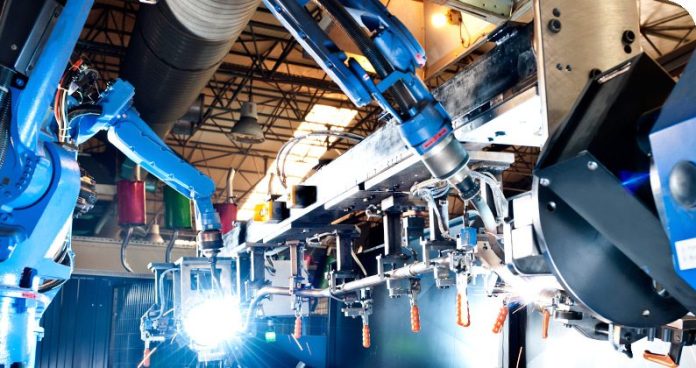The move to a ‘lights-out’ factory has already begun, but the developing transition requires an overhaul of industrial facilities, equipment, systems and people if it is to go the distance. Transformation of the manufacturing industry, or ‘vertical’ in service-provider parlance, must also make way for full integration of many ‘horizontal’ technologies.
ABI Research has considered these horizontal technologies, and come up with eight, out of “dozens”, which cannot be ignored by manufacturers, nor by any enterprise vertical actually. These include connectivity, additive manufacturing, drones, mobile collaborative robotics, industrial internet-of-things (IoT) platforms and AI.
Some have taken root already, notably industrial IIoT platforms and edge intelligence; industrial operatives will start to “piece together” other technologies during the next decade to make factories less dependent on fixed assembly lines and immobile assets, says ABI.
Each step in this transformation will make plants and their workers more productive, says ABI. “Manufacturers want technologies they can implement now without disrupting their operations,” says Pierce Owen, principal analyst at ABI Research.
“They will change the way their employees perform jobs with technology if it will make them more productive, but they have no desire to rip out their entire infrastructure to try something new. This means technologies that can leverage existing equipment and infrastructure, such as edge intelligence, have the most immediate opportunity.”
Vendors that open up their solutions and integrate with legacy equipment and parallel technologies will carve out a share of this growing opportunity. “Implementation will go step-by-step over multiple decades, but ultimately, how we produce goods will change drastically from what we see today,” says Owen.
Here are the eight, as selected by ABI.
1 | ADDITIVE MANUFACTURING
Additive manufacturing (AM) describes technologies that build three-dimensional objects one superfine layer at a time. “After decades of producing little more than prototypes, the AM winter has ended and new growth has sprung up,” says ABI. It was certainly a fixture on the show floor at Hannover Messe in April. ABI also points to recent bets by the likes of GE and Siemens, with the former acquiring Arcam and Concept in 2016, and the latter debuting its own AM platform in April. Others to watch among AM specialists include EOS, Stratasys, HP and 3D Systems, says ABI.
2 | ARTIFICIAL INTELLIGENCE
This covers both the fields of artificial intelligence (AI) and machine learning (ML). There are differences. AI creates computer programmes capable of thinking about complex situations, much as humans make decisions. ML is the process of marrying algorithms and statistics to hone the AI process continually. The differences are explained here. It is notable, European governments in particular are pinning major parts of their developing economic strategies on the integration of AI and ML into their industrial operations, and also the stimulation of their local tech scene.
3 | AUGMENTED REALITY
Robots are making their way onto factory floors, but many activities still require human capabilities, notably tasks that require high dexterity and flexibility, and an ability to improvise. This is where augmented reality (AR) comes in; it is well suited for training, collaboration and decision-making. It can help with staff training, providing provide a way to annotate real-time images of manufacturing processes with work instructions. AR guides can also ensure critical information is delivered on time, when one-off product configurations are required, and processes change.
4 | BLOCKCHAIN
The benefits of blockchain – principally immutability, traceability, and disintermediation – are just as compelling in manufacturing supply chain, as they are in other sectors. It provides a rapid and efficient way to record and store data. The challenge remains its implementation. Manufacturing goods are wildly varied, their data tends to be unstructured; imposing order in a distributed ledger is no mean feat.
5 | DIGITAL TWINS
As sexy as it gets, when it comes to new factory tech; digital twins are actually glorified CAD programmes, which provide near-real-time digital imagery of physical objects and processes, and can be used to inform operations. They can provide a complete digital footprint, from first concept to final delivery, accelerating time-to-market, performance, and quality. Innovative vendors in digital twins and simulation software include PTC, SAP, Siemens, and ANSYS, reckons ABI.
6 | EDGE INTELLIGENCE
The rise of edge computing spells the end of cloud computing, at least in its current form. That was. But there is work to be done to understand its implications and specifications. Defining where the edge of the network should be is a good start. The Industrial Internet Consortium, which has a number of work streams dedicated to the cause, makes clear the edge is a logical layer, rather than a specific physical divide. Its precise location is defined by the use case, along a “continuum of fundamental capabilities”, it says.
7 | IIOT PLATFORMS
Industrial IoT (IIoT) platforms must support many of these other technologies to better integrate them with the enterprise and each other, says ABI. “Those that can connect and support equipment from multiple manufacturers, such as PTC Thingworx and Telit deviceWISE, will last,” it says. In a parallel report, analyst house Gartner puts the leading IIoT platforms through their paces, and comes up with the best. PTC, Hitachi and SAP top the chart, it reckons, ahead of IBM, Software AG and Accenture. But the analyst house warn also that major challenges remain for IoT providers in the industrial space, including with market fragmentation and inconsistency.
8 | ROBOTICS
The above technologies have already started to converge, and robotics provide a physical representation of this convergence. “Robotics use AI and computer vision and connect to IIoT platforms where they have digital twins,” notes ABI. This connectivity and AI will increase in importance as more cobots join the assembly line and work alongside humans. The robotics vendors that can integrate the most deeply with other transformative technologies have the biggest opportunity. ABI singles out ABB, KUKA, FANUC, Universal Robots, Rethink Robotics and Yaskawa as companies that can.

